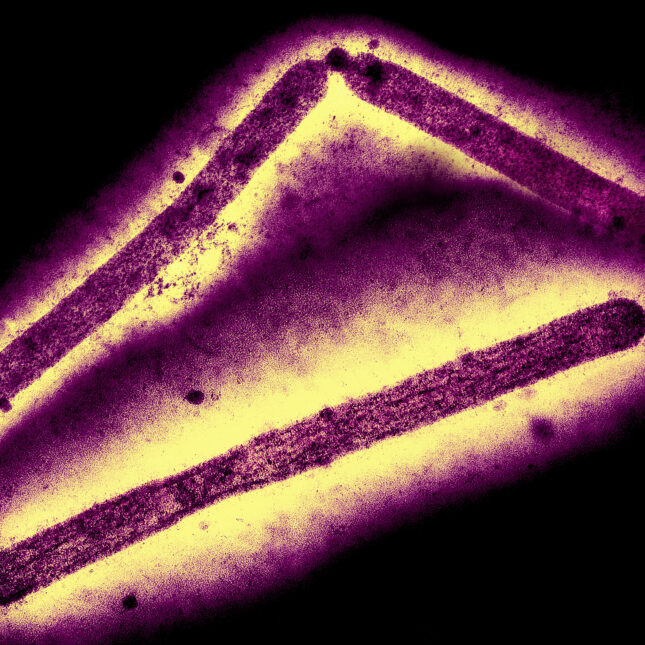
Vivien Dugan isn’t getting much sleep these days.
The director of the influenza division at the Centers for Disease Control and Prevention, Dugan is leading the team of CDC scientists that is working with partners — in the U.S. Department of Agriculture, the Food and Drug Administration, and state and local health departments — to respond to the H5N1 bird flu outbreak in dairy cattle.
The response has been pedal to the metal since the USDA announced on March 25 that a strange illness that had been affecting milk production in some herds since early this year was caused by bird flu. Since then, 36 herds in nine states have tested positive for the virus.
Assessing the risk from the situation and messaging it to the public is a balancing act, she admitted. While workers on affected dairy farms are being exposed to the virus — one has tested positive so far — for the individual American elsewhere, the risk is low, for the moment. Demetre Daskalakis, director of CDC’s National Center for Immunization and Respiratory Diseases — in which the flu division is housed — said Wednesday that 25 people have been tested for H5N1 in the context of this outbreak, and over 100 people have been monitored for symptoms because they were believed to have been exposed.
The responding agencies have long experience working with poultry farmers, who’ve been plagued by this virus for the past couple of years. But its move into cattle has been like crossing into a new country for the agencies. Dairy farmers have no experience with bird flu. Many farmers and farm workers haven’t been eager to cooperate with authorities.
In an ideal world, blood samples from people who had contact with the infected farm worker would have been studied to look for H5N1 antibodies to see if he transmitted the virus to anyone, a technique called a serology study. But Dugan said she believes that the people involved wouldn’t grant permission.
STAT asked Dugan about the work the CDC is doing, the complaints from scientists globally about the amount of information the United States has been sharing, and where the needle on her H5N1 risk meter sits right now. As we spoke, a colorful statue of a rooster was visible âÂÂÂÂâÂÂÂÂon a credenza behind her — apt decor for a flu researcher.
The interview has been edited for length and clarity.
The numbers of people tested and/or monitored seems to be implausibly low, given the numbers of workers who would have been exposed to the infected animals. How hard is the U.S. looking for cases?

We had a team pretty much ready to go six weeks ago, when this first really started to show up on our radar. But this is not the average poultry-worker response situation. These are dairy farms. The poultry space and poultry industry, they’ve been responding to H5 for the past 2 ½ years, really. There’ve been more than 8,000 people that have been monitored for symptoms in the H5 poultry space. It’s a different environment altogether when we’re talking about dairy cattle and dairy farms.
That said, we are really thinking about how we would go about doing the investigation we would normally do for a novel flu case — where they’re all nationally notifiable infections in people — in a way that makes scientific and epidemiological sense.
The states are really focusing on that, really trying to get as much information as they can. So it’s really more in that local space. We’re supporting them in that effort. Some states have been able to contact workers directly and actively monitor. Others, of course, have not been as successful.
So it’s a work in progress. We have a couple of potential locations that we’re trying to do more with in getting the logistics sorted out. But no studies have been completed yet.
No studies have been completed yet. Have any studies started?
That’s probably a good question for some of the impacted states. We don’t want to get ahead of them for any work they may be doing that we don’t have all the details on.
It sounds like your team that was ready to go didn’t go. And it sounds like from what you’re telling me that CDC is very much in the back seat on this one. That it’s the states or local authorities who are running this.
They have the authority, right? CDC does not have the authority to go into a state. We have to have an invite from state public health.
Have any states invited CDC in?
No. Not officially yet. We’re speaking to these partners if not once a day, more than that.
There are a lot of sensitivities. There are a lot of things that we as public health officials may not be aware of in thinking about dairy farms. We’re used to working with poultry farms and poultry workers where they’re culling all the birds. These cows are not being culled. So it’s a very different space.
We’re working very closely with the state public health partners, where potentially they might be a lead of a study. And we would be in the background supporting. Sometimes we don’t need to deploy a team, we can equip our state public health partners to do the information gathering and work collaboratively with them to do that.
There has been a single human case in Texas. Has anybody done serology testing around that individual? That would be an obvious place to start, would it not?
I don’t know that that was consented to. You have to have consent from people to follow up. Certainly it was something that was on our radar for what we would like to have and request, but to my knowledge, serology was not performed. (A report on the case published Friday in the New England Journal of Medicine confirmed Dugan’s belief. The infected person and his contacts would not consent to have blood drawn.)
The scientific world has been watching H5 for a long time. CDC has been very involved in that. And whenever there have been unusual outbreaks, this country has always pushed for rapid case finding and data sharing.
I’m hearing from people outside the United States that when the shoe is on the other foot, when the outbreak is here, they’re not seeing the information sharing that they would hope for, or even evidence that the work that is crucial to finding out whether or not this could get seeded into the human population is happening. Do you have any response to that?
It’s a complicated situation as far as [there are] new partners and new individuals and a different group of farm workers. We’re doing everything we can and thinking about messaging, multilingual messages, communications, PPE [personal protective equipment], biosecurity on farms, and collaboration with USDA to really protect workers. That is definitely one of our highest priorities, and it always is.
But also we’re really thinking about this in the medium and longer term of what allowing a virus to circulate within a new mammalian host could mean. I don’t think anybody really can predict what might happen, but we certainly know flu viruses change. And we do not want to give the virus that opportunity, if we can avoid it.
By the way, I think you need to add to your statue collection. The chicken needs a cow.
Yeah.
On data sharing, we are trying to be as forthcoming and as transparent as we can with the data that we have. I think we’re doing that in the “Spotlights” that we’re putting out every Friday. We got the Texas human virus sequence out as quickly as we could.
So I think we’re trying to do that as much as we can. We can always do more. But a lot of this, again, is our partnerships with the states. We defer to them. We have to be behind the scenes and let them talk about what’s going on in their state.
Can I ask about your personal read on the risk here? If this virus gets seeded into the cow population and it evolves in cows, what do you think this does to the human risk from H5N1?
[Dugan grimaced.] I think it would definitely impact the risk, for sure. Our current assessment of the risk to the general public health is low. That could change. And so I think we’re remaining very vigilant — if anything, more vigilant in this space.
These viruses change. If this were to become seeded in cows and become a cow-endemic virus, it certainly would increase that risk to people.
And certainly our pandemic planning [operation] has been really thinking about this and trying to be as vigilant as we can now, to try and understand not just current risk, but the future risk so that we’re as prepared as we can be.
But the risk could be quite big.
You said you still think the risk is low. But 15 years ago this spring, CDC was notified about two kids from California who had tested positive for swine flu who hadn’t had exposure to pigs or each other. Before April 17, 2009, the risk of a swine flu pandemic would have seemed pretty low. And then CDC got those two samples, and everything changed really fast. Do you think about that?
Well, yeah. It’s probably why I’m not sleeping very much right now.
I think that the threat of a pandemic is always looming in the flu space. The way that Dan Jernigan [Dugan’s predecessor] always described public health to me is that it is an art form. There’s a balance that you have to strike. There’s a difference in the pandemic risk versus the immediate risk right now. And so I think that’s what we’re trying to message to the average person who is walking about and living their lives. The risk to them is low.
But you’re right. It could absolutely change.
To submit a correction request, please visit our Contact Us page.










